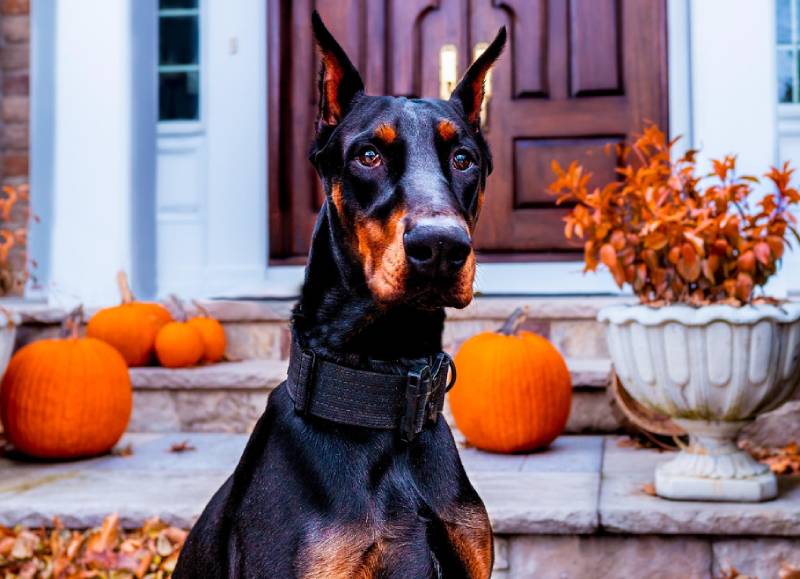Dogs are highly social animals, but they communicate very differently than humans do. Reading dog to dog body language is essential for keeping interactions safe and positive. In fact, experts note that dogs rarely bite “out of the blue” – there are almost always warning signals beforehand. Unfortunately, many people misinterpret or overlook these signals. As a long-time dog owner and trainer, I know firsthand that understanding canine body language can prevent scuffles, deepen the bond with your pup, and help you accurately gauge if a dog is happy, anxious, or stressed. In this article, we’ll break down key aspects of dog body behavior – from wagging tails to subtle facial cues – so you can confidently interpret what dogs are “saying” to each other and to us.
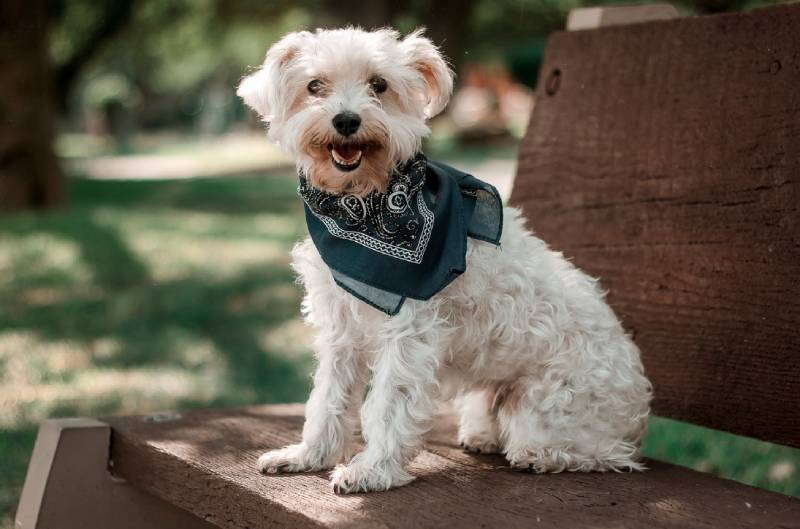
Tail-Wagging
Most people assume a wagging tail means a dog is happy. It’s not that simple. A wagging tail simply indicates emotional arousal – the dog is excited or stimulated, but not necessarily in a good way. To decode a dog’s intent, you have to look at tail position and movement – and even ask, do dogs wag their tails on purpose?

Low, tucked tail with a rapid wag: “I am scared or unsure.” A tail held low or between the legs usually signals fear or anxiety. Even if it’s wagging quickly, the dog is likely nervous, not friendly.
High, stiff wag:“I am agitated or on high alert.” When a dog’s tail is raised like a flag and wagging in short, tight motions, especially if the dog’s body looks tense and leans forward, it can mean excitement with a possible aggressive edge. Proceed with caution if you see this posture – the dog may be over-aroused and not in a welcoming mood. In some cases, dogs in this heightened state may also begin vocalizing excessively, such as dog barking at night.
Neutral position, loose wag: “I am comfortable or friendly.” A tail wagging in a relaxed, sweeping motion at mid-height usually indicates a content, approachable dog. Often the dog’s whole butt wiggles along with the tail – a sign of a happy, friendly state.
Raised Hackles
When a dog’s hackles are raised – that is, the hair along the neck and back fluffs up – it means the dog is highly aroused emotionally. This reaction, technically called piloerection, is like goosebumps in humans. Raised hackles by themselves don’t tell you whether the dog is feeling aggressive, afraid, or excited – only that something has really caught their attention. You might see a dog’s hackles rise when they meet a new dog or hear a strange noise. Often it’s an involuntary response to stress or excitement.
Importantly, raised hackles often accompany other body language. For instance, a fearful dog might have hackles up and a tucked tail with a stiff body, showing he’s upset or insecure. On the other hand, an excited dog might raise hackles out of intense interest without any aggressive intent. In all cases, hackles are a red flag for high arousal – it’s a sign to observe the dog closely and gently diffuse any tension if necessary. Give a hackled dog space until you can determine if his arousal is positive or negative.
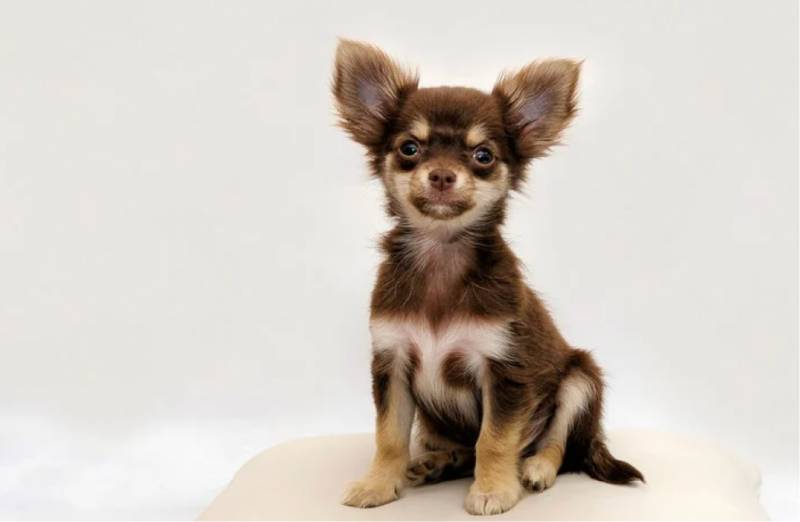
Posture
A dog’s overall body posture and weight distribution speak volumes about their mood. Subtle shifts – leaning forward, cowering down, rolling over – are all part of dog to dog body language. Let’s look at a few key postures:
Playful/Invitational posture: When dogs initiate play, they often use the classic “play bow” – front legs extended with chest low to the ground and hindquarters in the air – as a friendly invitation to romp. This exaggerated, bouncy posture (often with a loose wagging tail and a goofy grin) signals to other dogs, “I just want to play!” and is usually answered with a play bow or happy chase in return. This same exuberance can also be directed at humans, sometimes leading to behaviors like dog jumping on people, especially when the dog is overly excited during greetings.
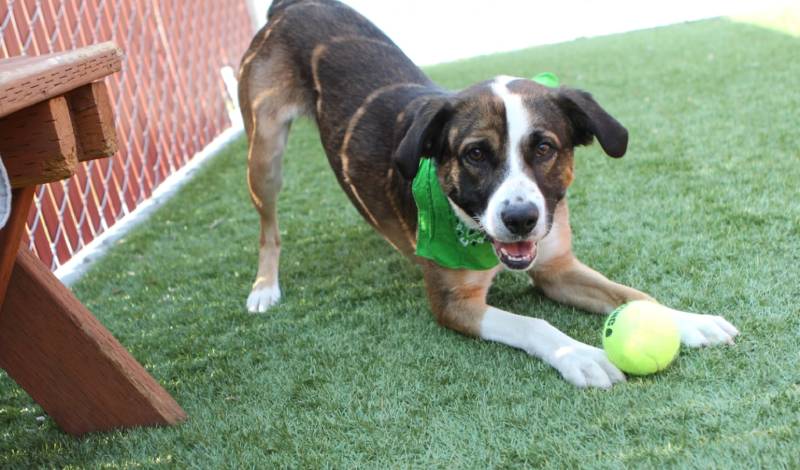
Confident or alert posture: A dog standing tall with its weight shifted forward is trying to get closer to something – possibly out of interest or possible challenge. If a dog stiffens their legs, puffs out their chest, and leans in toward another dog, they may be attempting to appear larger and more assertive. This forward posture, especially when paired with other bold body language (tail held high and rigid, ears forward, staring eyes), can signal dominance or offensive intent. In a meet-and-greet, if one dog approaches another very stiffly and head-on, it’s wise to go slowly – that dog might be testing the other’s boundaries rather than greeting politely. While domestic dogs display these behaviors in parks and backyards, it’s interesting to consider can dogs live in the wild and how such instincts would serve them outside human care.
Fearful or submissive posture: A nervous dog often tries to make itself look small. You might see a dog cowering close to the ground, head down, and tail tucked. This posture says, “I mean no harm”. The extreme of this is when a dog rolls onto their back and exposes their belly. People often assume this belly-up pose is a request for a rub, and if the dog is loose and wiggly, it could be. But if the dog is very still, with tail tucked and lips tight while on their back, they are not asking for a belly rub – they’re showing intense submission or fear. This dog is essentially saying, “Please don’t hurt me.” In fact, a highly anxious submissive dog might even dribble a little urine while on their back as an appeasement gesture.
Freezing up: One posture that many first-time dog owners miss is the freeze – when a dog goes stiff as a statue. If during a dog-to-dog interaction you notice one dog suddenly hold perfectly still, it’s a serious sign. A dog may freeze if they’re highly uncomfortable, afraid, or guarding something (like a toy or food). This rigid stillness is a low-level warning on the “ladder” of aggression. Reactive dogs – those that are more easily triggered by certain stimuli, such as other dogs or unfamiliar environments – may freeze before escalating to barking, lunging, or snapping. In practical terms, a freezing dog is saying, “I don’t like this, and I might escalate if it continues.” Respect this signal by calmly removing the dog from the situation or giving them more space.
Facial Expressions
Dogs have expressive faces, but their expressions often mean something different than a human’s. Learning to read a dog’s facial cues will greatly improve your understanding of dog body language:
Mouth and lips: Pay attention to how a dog holds their mouth. A relaxed dog might have a soft, slightly open mouth that almost looks like a “smile.” However, bearing teeth is context-dependent. An aggressive snarl is usually obvious – the dog’s lips curl back (often in a tight C-shape at the corners) to expose front teeth, accompanied by a growl or stiff posture. This means “Back off!”
Yawning: Humans yawn when tired or bored, but dogs yawn mainly when they’re stressed or unsure. A yawn is a common calming signal in dog language. For example, a dog might yawn when a situation feels tense – it’s basically an attempt to ease the stress (for themselves or others). You might even notice your dog yawning at the vet’s office or when a stranger pets them too enthusiastically. So if your dog suddenly yawns during an interaction with another dog, it’s likely saying, “I’m a bit uncomfortable; let’s keep things peaceful.”
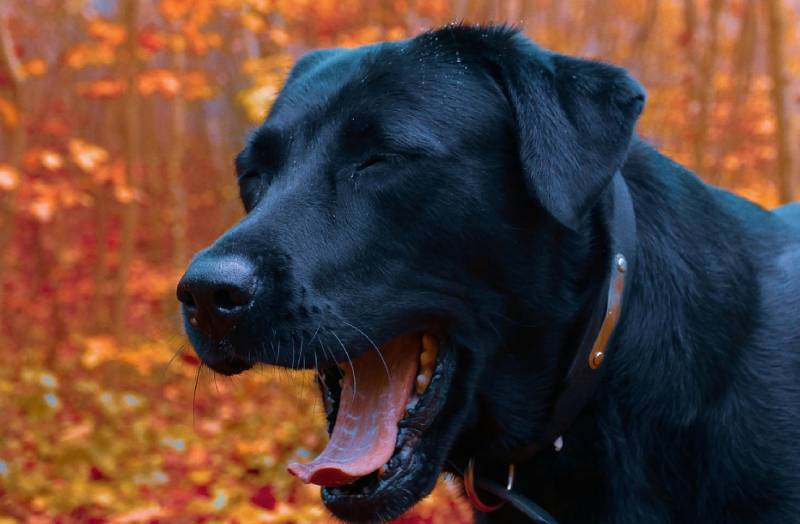
Lip licking: Another subtle stress signal is a quick tongue flick or lip lick. Dogs will, of course, lick their lips after a tasty treat (and yes, can dogs eat raspberries?), but when you see a dog repeatedly flicking its tongue out in the absence of food, it often means the dog is anxious or feeling pressured. Many times it’s so fast you might miss it. People sometimes misread this as the dog “wanting to lick your face,” but in context (like during a tense greeting with another dog), it’s usually a sign the dog is uneasy. In dog-to-dog greetings, if one dog keeps licking its lips while approaching, that dog may be a bit nervous about the encounter.
“Smiling” vs. snarling: We touched on this with the submissive grin, but it bears repeating: a snarl with teeth bared, nose wrinkled, and low growl is a clear threat – the dog is saying “I’m ready to bite if pushed.” On the flip side, a dog can also pull back the lips in a non-threatening way. Context and body language are everything. Check the rest of the dog’s body: is the tail wagging loosely or tucked tight? Are the ears relaxed or pinned back? Are the muscles tense or loose? A full-body wag and “smiley” grimace usually indicate the dog is being playful or appeasing, not aggressive. And remember: not all dogs have expressive faces – breeds with loose jowls (like Bulldogs) or very furry faces (like Chow Chows) might rely more on posture and other signals.
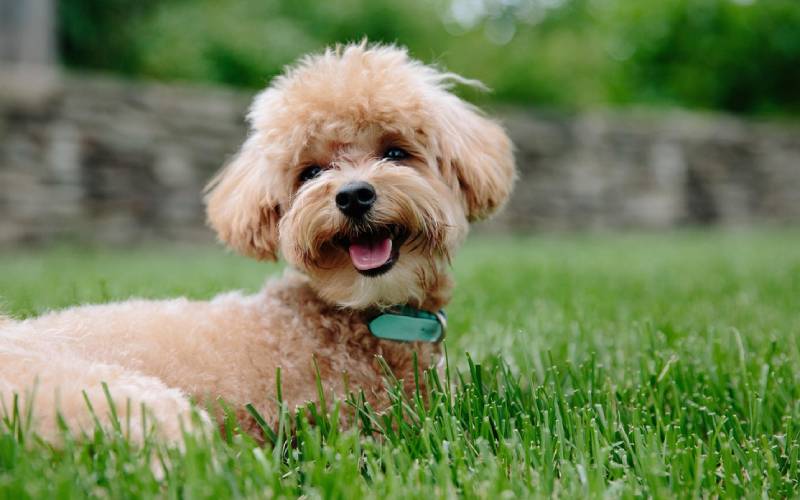
Eyes
You can tell a lot about a dog’s inner state by looking at their eyes – if you know what to look for. Dogs communicate with their eyes in ways both obvious and subtle:
“Soft” vs. “hard” eyes: A content or relaxed dog often has soft eyes – the lids may be relaxed or even squinting a little, and the gaze is gentle. Soft eyes indicate the dog is happy, calm, or just generally non-confrontational. In contrast, hard eyes have a fixed, unblinking stare and might appear cold or intense. This hard stare is often seen in dogs guarding a valued resource or in the moments before a dog reacts aggressively. If you catch a dog giving another dog (or a person) a hard, locked-on stare, that is a serious warning sign. In dog interactions, a hard eye usually precedes a growl or snap, so take it as a red light – it’s time to intervene or create distance.

Whale eye (whites of the eyes showing): When a dog’s eyes go wide such that you can see the whites at the corners or rim, that’s commonly called “whale eye.” It’s a sign the dog is anxious, frightened, or feeling defensive. For example, if a dog stiffens up when another dog approaches his bone and you see a crescent of white in his eye, that dog is very uncomfortable and possibly about to react. Many dogs will show whale eye when they’re touched in a way they dislike (like a hug or a pat on top of the head) – the dog’s way of saying “I’m not okay with this”. In dog-to-dog greetings, whale eye might appear if one dog is getting overwhelmed. It often comes along with a still body or a tucked tail. If you notice a dog giving whale eye during an interaction, it’s best to pause and give that dog some breathing room.
Blinking and squinting: A dog that is blinking slowly or squinting in the presence of another dog is generally showing friendliness or submission. It’s akin to the “soft eyes” – things are going well. Rapid blinking or obviously averted eyes, as mentioned, can be a stress signal. Some friendly dogs will even “wink” or just have a naturally squinty happy face (think of a content Golden Retriever) – context will tell you if it’s just their facial structure or a deliberate signal.
Ears
Ear position is another crucial piece of dog body language, though it’s sometimes overlooked – especially in breeds with floppy ears. Dogs use their ears almost like semaphores to express emotion and intent:
Ears pricked forward: When a dog’s ears are up and pointed forward (or upright in breeds with erect ears), the dog is alert and interested in something. You’ll see forward ears when a dog spots something intriguing – it could be friendly curiosity (like seeing a buddy or a person with treats), or it could be more intense (like fixating on a squirrel or an unfamiliar dog). In combination with a relaxed body and wagging tail, forward ears just mean interest. But if those ears are forward alongside a stiff body and hard stare, the dog could be on the offensive. Many confident or dominant dogs will push their ears forward as part of an assertive posture. Essentially, forward ears indicate focus – the dog is tuning in closely to whatever has their attention.
Ears pulled back or flattened: When a dog slicks its ears back against its head, it usually signals unease, fear, or submission. Slightly pulled-back ears can also be a friendly, appeasing gesture – a dog that’s happily greeting you might slick his ears back and wag low, saying “I’m so happy, you’re the boss!” However, flattened ears (pressed tight to the head) accompanied by cowering posture or yawning are a clear sign the dog is uncomfortable or anxious. In dog-to-dog play, you might notice the more submissive dog keeping its ears back, while the more confident playmate’s ears are forward. And if a dog’s ears go from forward to suddenly pinned back when another dog approaches, that dog is probably saying, “I’m a bit nervous about this.”
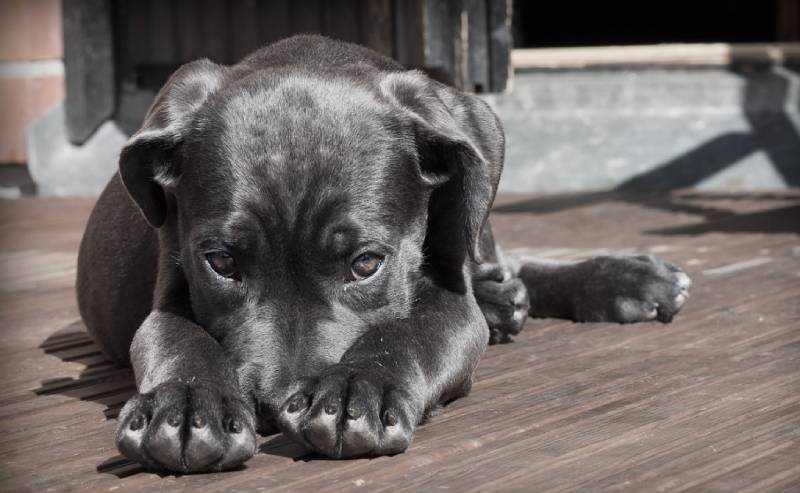
One ear up, one down:Sometimes dogs will have one ear cocked up and the other partially back – this can mean the dog is feeling ambivalent or unsure. It’s like their ears haven’t decided how to react. It’s often a fleeting state as they gather information.
Dog ears hot: If your dog’s ears feel unusually warm to the touch, it can be a subtle indicator of physical or emotional stress. Warm ears may result from recent exercise, excitement, or mild overheating – particularly in warm weather. However, persistently hot dog ears could also point to an underlying issue like infection, inflammation, or fever. It’s important to consider the context: if your dog is otherwise acting normal, a bit of warmth might just be from exertion or sun exposure.
Conclusion
Understanding dog to dog body language is like learning a new language—once you grasp it, you’ll see how dogs communicate through tail wags, posture, facial expressions, and more. Watch the whole dog: tail, ears, eyes, mouth, and stance all work together. These cues help prevent conflict, ease anxiety, and deepen trust. With awareness, you’ll spot the signs of joy, stress, or hesitation and respond in a way your dog understands. This leads to safer interactions, stronger bonds, and a more peaceful multi-dog household. By learning their language, you become more than an owner—you become a trusted, respectful partner.
FAQs
How can you tell if a dog likes another dog?
You can tell a dog likes another dog by observing friendly body language: relaxed posture, wagging tail, play bows, and mutual sniffing. They may initiate gentle play, follow each other, or take turns chasing. Signs of comfort include soft eyes, loose movements, and shared space without tension. If both dogs appear happy, relaxed, and eager to interact, it’s a strong indication they enjoy each other’s company.
Why do dogs turn their back to other dogs?
Dogs often turn their back to other dogs as a sign of trust and non-aggression. In canine body language, exposing their back signals that they don’t feel threatened and aren’t a threat themselves. It can also be a calming signal, used to defuse tension or avoid conflict. This dog body posture helps maintain peaceful social interactions among dogs, especially during greetings or in unfamiliar situations. It’s a normal, healthy part of dog communication.
What is an uncomfortable dog’s body language?
An uncomfortable dog may show body language like tucked tail, flattened ears, lip licking, yawning, or avoiding eye contact. They might cower, tremble, or shift their weight away. Raised hackles, tense body, or sudden stillness can also indicate stress.
Visited 1 times, 1 visit(s) today










